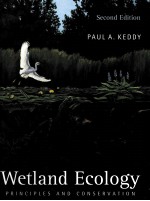图书介绍
WETLAND ECOLOGY PRINCIPLES AND CONSERVATION SECOND EDITIONPDF|Epub|txt|kindle电子书版本网盘下载

- 著
- 出版社: CAMBRIDGE UNIVERSITY PRESS
- ISBN:0521519403
- 出版时间:2010
- 标注页数:497页
- 文件大小:151MB
- 文件页数:515页
- 主题词:
PDF下载
下载说明
WETLAND ECOLOGY PRINCIPLES AND CONSERVATION SECOND EDITIONPDF格式电子书版下载
下载的文件为RAR压缩包。需要使用解压软件进行解压得到PDF格式图书。建议使用BT下载工具Free Download Manager进行下载,简称FDM(免费,没有广告,支持多平台)。本站资源全部打包为BT种子。所以需要使用专业的BT下载软件进行下载。如BitComet qBittorrent uTorrent等BT下载工具。迅雷目前由于本站不是热门资源。不推荐使用!后期资源热门了。安装了迅雷也可以迅雷进行下载!
(文件页数 要大于 标注页数,上中下等多册电子书除外)
注意:本站所有压缩包均有解压码: 点击下载压缩包解压工具
图书目录
1 Wetlands:an overview1
1.1 Definitions and distribution2
1.2 Wetland classification4
1.3 Wetland soils15
1.4 Flood tolerance:the primary constraint18
1.5 Secondary constraints produce different types of wetlands22
1.6 Wetlands provide valuable functions and services28
1.7 Causal factors in wetland ecology30
1.8 More on definitions and classification of wetlands34
Conclusion38
2 Flooding43
2.1 Flooding and humans:an old story46
2.2 Some biological consequences of flooding48
2.3 A survey of water level fluctuations54
2.4 General relationships between wetlands and water level fluctuations67
2.5 Reservoirs,dams,and floodplains68
2.6 Predicting consequences for wetlands74
Conclusion77
3 Fertility79
3.1 Fertility and plants80
3.2 Infertile wetlands are constrained by low nutrient levels84
3.3 Other issues related to fertility88
3.4 Animals and fertility94
3.5 Eutrophication:too much of a good thing96
3.6 Calcium interacts with fertility in peatlands104
3.7 Fertility and hydrology explain a great deal about wetlands106
Conclusion107
4 Disturbance109
4.1 Disturbance has four properties111
4.2 Disturbance triggers regeneration from buried propagules112
4.3 Examples of disturbance controlling the composition of wetlands113
4.4 Disturbances can create gap dynamics130
4.5 Measuring the effects of disturbance in future studies133
Conclusion136
5 Competition139
5.1 Some examples of competition in wetlands141
5.2 Competition is often one-sided145
5.3 Competition for light produces competitive hierarchies146
5.4 Dominant plants are often larger than subordinate plants148
5.5 Escape in space:competition in patches148
5.6 Escape in time:competition and disturbance149
5.7 Gradients provide another way of escaping in space150
5.8 Competition gradients produce centrifugal organization153
5.9 Rare animals are found in peripheral habitats:the case history of the bog turtle156
Conclusion158
6 Herbivory161
6.1 Some herbivores have large impacts on wetlands162
6.2 Wildlife diets document which animals eat which plants166
6.3 Impacts of some other herbivores on wetlands168
6.4 Plants have defenses to protect them against herbivores174
6.5 General patterns in herbivory179
6.6 Three pieces of relevant theory181
Conclusion186
7 Burial189
7.1 Exploring rates of burial192
7.2 Burial changes the species composition of wetlands201
7.3 Burial has impacts on many animal species205
7.4 Sedimentation,sediment cores,and plant succession206
7.5 Ecological thresholds:burial,coastlines,and sea level207
7.6 So is sediment bad or good?210
Conclusion211
8 Other factors213
8.1 Salinity214
8.2 Roads222
8.3 Logs and coarse woody debris225
8.4 Stream type227
8.5 Human population density is becoming a key factor229
Conclusion233
9 Diversity235
9.1 Introduction to diversity in wetlands236
9.2 Four general rules govern the number of species in wetlands238
9.3 Selected examples242
9.4 Some theory:a general model for herbaceous plant communities255
9.5 More theory:the dynamics of species pools261
9.6 Conservation of biological diversity264
Conclusion265
10 Zonation:shorelines as a prism269
10.1 The search for fundamental principles270
10.2 Shorelines provide a model system for the study of wetlands271
10.3 Possible mechanisms of zonation273
10.4 Zonation and changing sea level286
10.5 Statistical studies of zonation289
10.6 General lessons from analysis of zonation298
Conclusion299
11 Services and functions301
11.1 Wetlands have high production302
11.2 Wetlands regulate climate306
11.3 Wetlands regulate the global nitrogen cycle310
11.4 Wetlands support biological diversity314
11.5 Wetlands provide recreation and cultural services317
11.6 Wetlands reduce flood peaks319
11.7 Wetlands record history323
11.8 Adding up the services:WWF and MEA evaluate wetland services325
Conclusion328
12 Research:paths forward331
12.1 Some context:the great age of explorers332
12.2 Four basic types of information334
12.3 Limitations to species-based research337
12.4 Empirical ecology338
12.5 Assembly rules driven by key factors341
12.6 Simplification through aggregation into groups347
12.7 Six tactical guidelines360
Conclusion363
13 Restoration365
13.1 The importance of understanding wetland restoration366
13.2 Three examples367
13.3 More on principles of restoration373
13.4 More examples377
13.5 One big problem:invasive species383
13.6 A brief history of restoration385
Conclusion387
14 Conservation and management391
14.1 Humans have greatly changed wetlands392
14.2 Wetlands have changed with time397
14.3 Two views on conservation objectives400
14.4 Protection:creating reserve systems403
14.5 Problems and prospects of reserve systems411
14.6 More on restoration415
14.7 So what shall we create with restoration?416
14.8 Indicators:setting goals and measuring performance417
14.9 Humans as the biggest problem424
Conclusion425
References427
Index476
The color plates are situated between pages238